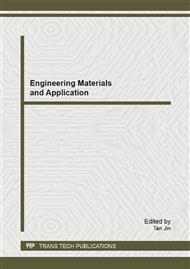p.73
p.77
p.83
p.87
p.91
p.97
p.103
p.109
p.115
Surface Morphology and Structural Investigation of TiN Nanocrystal Thin Films Grown with Different N2 Concentration
Abstract:
In this work, new information on surface morphology, phase and local structure of titanium nitride (TiN) nanocrystal thin films grown with different nitrogen gas concentration by direct current (DC) magnetron sputtering is provided. Surface morphology of the thin films was studied by field emission scanning electron microscope (FE-SEM). Phase and local structure of the TiN nanocrystals were determined by X-ray diffraction spectroscopy (XRD) and X-ray absorption fine structure (XAFS). The TiN nanocrystals were prepared on silicon substrates. N2/Ar gases were used as reactive gases for sputtering Ti target. The amount of these two reactive gases was varied at different ratios (N2/Ar), i.e. 100:0, 75:25, 50:50 and 25:75 respectively. Our results suggested that sputtering Ti target with high N2/Ar gas raSubscript texttio (higher than 75%) provides good TiN layer while sputtering with low N2/Ar gas ratio (lower than 25%) gives Ti layer instead of TiN. In addition, sputtering with 50% N2/Ar gas ratio gives a multiphase system between TiN and Ti. Local structure parameters of these nanocrystal thin films are reported.
Info:
Periodical:
Pages:
91-96
Citation:
Online since:
January 2013
Keywords:
Price:
Сopyright:
© 2013 Trans Tech Publications Ltd. All Rights Reserved
Share:
Citation:


